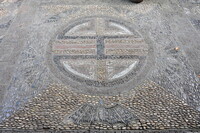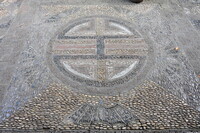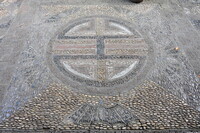| dc.coverage.spatial | Site: Suzhou, Jiangsu, China | en_US |
| dc.coverage.temporal | 1044 (creation); 1696 (restoration) | en_US |
| dc.creator | Su Shunqin | en_US |
| dc.date | 1044 | en_US |
| dc.date.accessioned | 2013-08-30T17:12:40Z | |
| dc.date.available | 2013-08-30T17:12:40Z | |
| dc.date.issued | 1044 | en_US |
| dc.identifier | 231507 | en_US |
| dc.identifier.other | archrefid: 2378 | en_US |
| dc.identifier.uri | http://hdl.handle.net/1721.3/139603 | |
| dc.description | Pebble mosaic inlaid inside entrance to garden mosaic representing five blessings and long life (ringed with five bats); Various factors contributed to Suzhou’s unique cultural importance. Its moderate climate made it an excellent retirement city for government officials, and hence wealthy patronage. The Great Wave Pavilion was built in 1044 CE by the Song Dynasty poet Su Shunqing [Shunqin], on the site of a pre-existing imperial flower garden ca. 960 CE. It is the oldest of the UNESCO gardens in Suzhou, keeping its original Song Dynasty layout. The name is derived from a verse in the poem "Fishermen" by Qu Yuan (ca. 340 BCE-278 BCE), a poet from the southern state of Chu during the Warring States Period, in his book Songs of the South, "If the Canglang River is dirty I wash my muddy feet; If the Canglang River is clean I wash my ribbon". This verse alludes to an honest official who removes himself from politics rather than act in a corrupt manner. Su Shunqin choose this to express his feelings after his removal from office. In 1955 the garden was opened to the public and in 2000 it was added to the UNESCO world cultural heritage monuments. Source: Wikipedia; http://en.wikipedia.org/wiki/Main_Page (accessed 5/10/2011) | en_US |
| dc.format.medium | wood; stucco; stone; landscaping | en_US |
| dc.rights | © Scott Gilchrist, Archivision, Inc. | en_US |
| dc.subject | botanical | en_US |
| dc.subject | decorative arts | en_US |
| dc.subject | landscape | en_US |
| dc.subject | Gardens | en_US |
| dc.subject | Chinese | en_US |
| dc.subject | Song (Chinese style) | en_US |
| dc.title | Garden of the Great Wave Pavilion | en_US |
| dc.title.alternative | Cāng Làng Tíng | en_US |
| dc.title.alternative | 沧浪亭 | en_US |
| dc.type | image | en_US |
| dc.rights.access | Licensed for educational and research use by the MIT community only | en_US |
| dc.identifier.vendorcode | 2A2-C-SU-SWP-B2 | en_US |
| vra.culturalContext | Chinese | en_US |
| vra.technique | carving (processes), construction (assembling), gardening | en_US |
| vra.worktype | garden | en_US |
| vra.worktype | garden structure | en_US |
| dc.contributor.display | Su Shunqin (Chinese landscape architect, 1008-1048) | en_US |



